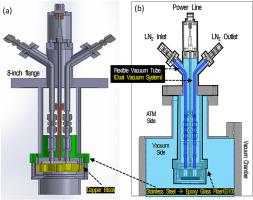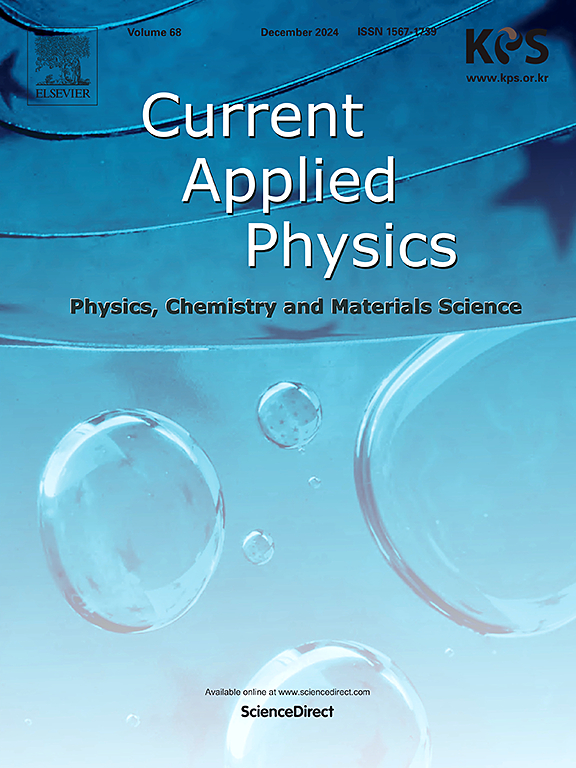低温冷却方法对自旋电子学应用中直流磁控溅射等离子体源的显著改进
IF 3.1
4区 物理与天体物理
Q3 MATERIALS SCIENCE, MULTIDISCIPLINARY
引用次数: 0
摘要
本研究研究了低温冷却系统对直流磁控溅射等离子体源的显著增强,重点研究了其对薄膜沉积过程的影响。磁控溅射等离子体源的效率直接取决于等离子体源头内永磁体产生的面内磁场。然而,当等离子体点火导致系统温度升高时,永磁体会严重退化。在这种情况下,低温冷却系统有效地克服了这一限制,提高了等离子体源的磁通密度和性能稳定性。实验结果表明,低温冷却提高了铁磁性(钴)和非磁性(钨)材料的沉积速率和膜均匀性。以钴(Co)和钨(W)为代表,与水冷系统相比,沉积速率分别提高了约27%和19%,均匀性分别提高了18%和19%。此外,低温冷却方法允许使用更厚的铁磁目标,磁性目标厚度限制广泛扩展到5.0 mm,这可以减少维护成本和过程中断。从系统的数值模拟中可以看出,由于薄磁靶,观察到强烈的磁场畸变,并可能导致等离子体源效率的降低。此外,永磁体的面内磁场随系统温度的降低而显著增加。该研究突出表明,磁控溅射等离子体源的低温冷却方法是提高自旋电子器件薄膜沉积工艺效率和可靠性的变革性技术。本文章由计算机程序翻译,如有差异,请以英文原文为准。

The significant improvements of DC magnetron sputtering plasma source via cryogenic cooling method for spintronics applications
This study investigates the significant enhancement of DC magnetron sputtering plasma sources using a cryogenic cooling system to focus on its impact on thin-film deposition processes. The efficiency of magnetron-sputtering plasma sources directly depends on the in-plane magnetic fields, which are generated by permanent magnets installed inside the plasma source head. However, the permanent magnets are severely deteriorated when the system temperature is increased due to the plasma ignitions. In this case, the cryogenic cooling system effectively overcomes this limitation and it can improve the magnetic flux density and performance stability of the plasma source. Experimental results demonstrate that cryogenic cooling enhances deposition rates and film uniformity for both ferromagnetic (cobalt) and non-magnetic (tungsten) materials. Cobalt (Co) and tungsten (W) targets serve as representative examples, with deposition rates improving by approximately 27 % and 19 %, and uniformities increasing by 18 % and 19 %, respectively, compared to water-cooled systems. Additionally, the cryogenic cooling method allows for the use of thicker ferromagnetic targets that the magnetic target thickness limit is widely extended to 5.0 mm, which can reduce maintenance costs and process interruptions. From the systematic numerical simulations, one can be revealed that a strong magnetic field distortion due to a thin magnetic target is observed and it can occur the degradation of the efficiency of the plasma source. Moreover, the in-plane magnetic fields from permanent magnets are dramatically increased with decreasing the system temperatures. This study can highlight that the cryogenic cooling method of the magnetron sputtering plasma source is a transformative technology to improve the efficiency and reliability of the thin film deposition process for spintronic devices.
求助全文
通过发布文献求助,成功后即可免费获取论文全文。
去求助
来源期刊

Current Applied Physics
物理-材料科学:综合
CiteScore
4.80
自引率
0.00%
发文量
213
审稿时长
33 days
期刊介绍:
Current Applied Physics (Curr. Appl. Phys.) is a monthly published international journal covering all the fields of applied science investigating the physics of the advanced materials for future applications.
Other areas covered: Experimental and theoretical aspects of advanced materials and devices dealing with synthesis or structural chemistry, physical and electronic properties, photonics, engineering applications, and uniquely pertinent measurement or analytical techniques.
Current Applied Physics, published since 2001, covers physics, chemistry and materials science, including bio-materials, with their engineering aspects. It is a truly interdisciplinary journal opening a forum for scientists of all related fields, a unique point of the journal discriminating it from other worldwide and/or Pacific Rim applied physics journals.
Regular research papers, letters and review articles with contents meeting the scope of the journal will be considered for publication after peer review.
The Journal is owned by the Korean Physical Society.
 求助内容:
求助内容: 应助结果提醒方式:
应助结果提醒方式:


